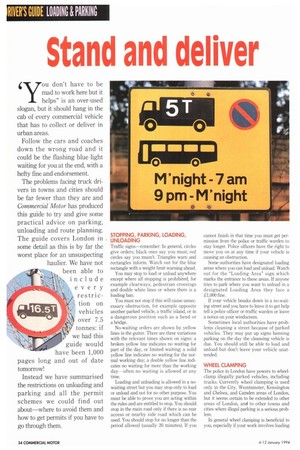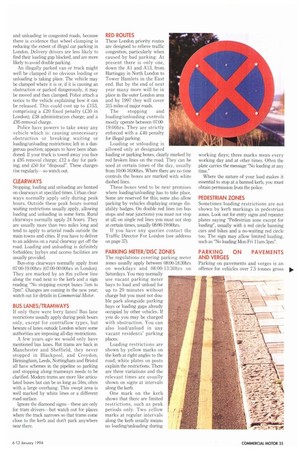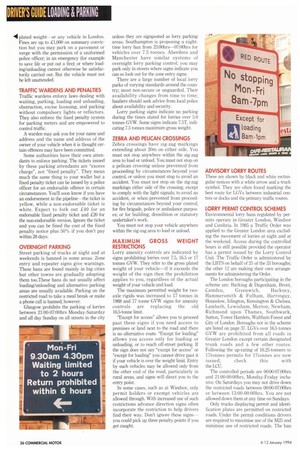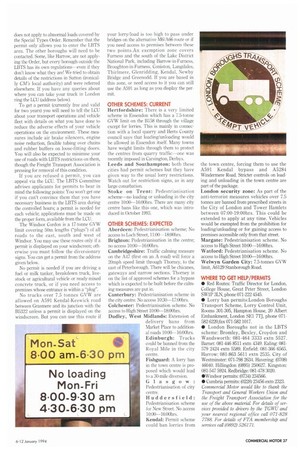Stand and deliver
Page 36

Page 37

Page 38

Page 39

If you've noticed an error in this article please click here to report it so we can fix it.
4ou don't have to be
mad to work here but it helps" is an over-used slogan, but it should hang in the cab of every commercial vehicle that has to collect or deliver in urban areas.
Follow the cars and coaches down the wrong road and it could be the flashing blue light waiting for you at the end, with a hefty fine and endorsement.
The problems facing truck drivers in towns and cities should be far fewer than they are and Commercial Motor has produced this guide to try and give some practical advice on parking, unloading and route planning. The guide covers London in some detail as this is by far the worst place for an unsuspecting
haulier. We have not been able to include every restric tion on vehicles over 7.5 tonnes: if 0, we had this
guide would have been 1,000 pages long and out of date tomorrow!
Instead we have summarised the restrictions on unloading and parking and all the permit schemes we could find out about—where to avoid them and how to get permits if you have to go through them.
STOPPING, PARKING, LOADING, UNLOADING Traffic signs—remember: In general, circles give orders; black ones say you must; red circles say you musn't. Triangles warn and rectangles inform. Watch out for the blue rectangle with a weight limit warning ahead.
You may stop to load or unload anywhere except where all stopping is prohibited, for example clearways, pedestrian crossings and double white lines or where there is a loading ban.
You must not stop if this will cause unnecessary obstruction, for example opposite another parked vehicle, a traffic island, or in a dangerous position such as a bend or a bridge.
No-waiting orders are shown by yellow lines in the gutter. There are three variations with the relevant times shown on signs: a broken yellow line indicates no waiting for part of the day, or limited waiting; a solid yellow line indicate; no waiting for the normal working day; a double yellow line indicates no waiting for more than the working day—often no waiting is allowed at any time.
Loading and unloading is allowed in a nowaiting street but you may stop only to load or unload and not for no other purpose. You must be able to prove you are acting within the rules and are entitled to stop. You should stop in the main road only if there is no rear access or nearby side road which can be used. You should stop for no longer than the period allowed (usually 20 minutes). If you cannot finish in that time you must get permission from the police or traffic warden to stay longer. Police officers have the right to move you on at any time if your vehicle is causing an obstruction_ Some authorities have designated loading areas where you can load and unload. Watch out for the "Loading Area" sign which marks the entrance to these areas. If anyone tries to park where you want to unload in a designated Loading Area they face a £1,000 fine.
If your vehicle breaks down in a no-waitMg street and you have to leave it to get help tell a police officer or traffic warden or leave a notice on your windscreen.
Sometimes local authorities have problems cleaning a street because of parked vehicles. They may put up signs banning parking on the day the cleansing vehicle is due. You should still be able to load and unload but don't leave your vehicle unattended.
WHEEL CLAMPING The police in London have powers to wheelclamp illegally parked vehicles, including trucks. Currently wheel clamping is used only in the City, Westminster, Kensington and Chelsea, and Camden areas of London, but it seems certain to be extended to other areas of London, and to other towns and cities where illegal parking is a serious problem.
In general wheel clamping is beneficial to you, especially if your work involves loading and unloading in congested roads, because there is evidence that wheel clamping is reducing the extent of illegal cur parking in London. Delivery drivers are less likely to find their loading gap blocked, and are more likely to avoid double parking.
An illegally parked van or truck might well be clamped if no obvious loading or unloading is taking place. The vehicle may be clamped where it is or, if it is causing an obstruction or parked dangerously, it may be moved and then clamped. Police attach a notice to the vehicle explaining how it can be released. This could cost up to £153, comprising a £20 fixed penalty (L30 in London); £38 administration charge; and a £95 removal charge.
Police have powers to take away any vehicle which is: causing unnecessary obstruction or breaking waiting or loading/unloading restrictions; left in a dangerous position; appears to have been abandoned. If your truck is towed away you face a .C.95 removal charge; £12 a day for parking and £50 for "disposal". These charges rise regularly—so watch out.
CLEARWAYS Stopping, loading and unloading are banned on clearways at specified times. Urban clearways normally apply only during peak hours. Outside these peak hours normal waiting restrictions usually apply, allowing loading and unloading in some form. Rural clearways normally apply 24 hours. They are usually more than two miles long and tend to apply to arterial roads outside the main towns and cities. If you have to deliver to an address on a rural clearway get off the road. Loading and unloading is definitely forbidden; laybys and access facilities are usually provided.
Bus-stop clearways normally apply from 07;00-19.00hrs (07:00-00:00hrs in London). They are marked by an Rin yellow line along the road next to the kerb and a sign reading "No stopping except buses 7am to 7pm". Changes are coming in the new year; watch out for details in Commercial Motor.
BUS LANES/TRAMWAYS If only there were lorry lanes! Bus lane restrictions usually apply during peak hours only, except for contraflow types, but beware of lanes outside London where some authorities are imposing all-day restrictions.
A few years ago we would only have mentioned bus lanes, But trams are back in Manchester and Sheffield, they never stopped in Blackpool, and Croydon, Birmingham, Leeds, Nottingham and Bristol all have schemes in the pipeline so parking and stopping along tramways needs to be clarified. Modern trams are more like articulated buses but can be as long as 34m, often with a large overhang. This swept area is well marked by white lines or a different road surface.
Ignore the diamond signs— these are only for tram drivers—but watch out for places where the track narrows so that trams come close to the kerb and don't park anywhere near there. RED ROUTES These London priority routes are designed to relieve traffic congestion, particularly when caused by bad parking. At present there is only one, down the Al and A13, from Harringay in North London to Tower Hamlets in the East end. But by the end of next year many more will be in place in the outer London area and by 1997 they will cover 315 mils of major roads.
The stopping and loading/unloading controls mostly operate between 07:0019:00hrs. They are strictly enforced with a £40 penalty for illegal parking.
Loading or unloading is allowed only at designated loading or parking boxes, clearly marked by red broken lines on the road. They can be used at certain times of the day, usually from 10:00-16:00hrs. Where there are no time controls the boxes are marked with white dashed lines.
These boxes tend to be near premises where loading/unloading has to take place. Some are reserved for this; some also allow parking by vehicles displaying orange disability badges. On double red lines (on bus stops and near junctions) you must not stop at all; on single red lines you must not stop at certain times, usually 08:00-19:00hrs.
If you have any queries contact the Traffic Director For London (see address on page 37).
PARKING METER/DISC ZONES The regulations covering parking meter zones usually apply between 08:00-18:30hrs on weekdays and 08:00-13:30hrs on Saturdays. You may normally use vacant parking meter bays to load and unload for up to 20 minutes without charge but you must not double park alongside parking bays or loading gaps already occupied by other vehicles. If you do you may be charged with obstruction. You can also load/unload in any vacant residents' parking places.
Loading restrictions are shown by yellow marks on the kerb at right angles to the road; white plates on posts explain the restrictions. There are three variations and the relevant times are usually shown on signs at intervals along the kerb.
One mark on the kerb shows that there are limited restrictions, such as peak periods only. Two yellow marks at regular intervals along the kerb usually means no loading/unloading during
working days; three marks mean every working day and at other times. Often the plate carries the message "No loading at any time."
Where the nature of your load makes it essential to stop at a banned kerb, you must obtain permission from the police.
PEDESTRIAN ZONES Sometimes loading restrictions are not shown by kerb markings in pedestrian zones. Look out for entry signs and repeater plates saying "Pedestrian zone except for loading", usually with a red circle banning cars and bikes and a no-waiting red circle too. The sign may allow limited loading, such as "No loading Mon-Fri 11am-3pm".
PARKING ON PAVEMENTS AND VERGES Parking on pavements and verges is an offence for vehicles over 7.5 tonnes gross
44 plated weight—or any vehicle in London. Fines are up to £1,000 on summary conviction but you may park on a pavement or verge with the permission of a uniformed police officer, in an emergency (for example to save life or put out a fire); or where loading/unloading cannot otherwise be satisfactorily carried out But the vehicle must not be left unattended.
TRAFFIC WARDENS AND PENALTIES Traffic wardens enforce laws dealing with waiting, parking, loading and unloading, obstruction, excise licensing, and parking without compulsory lights or reflectors. They also enforce the fixed penalty system for parking meters and are empowered to control traffic.
A warden may ask you for your name and address and the name and address of the owner of your vehicle when it is thought certain offences may have been committed_ Some authorities have their own attendants to enforce parking. The tickets issued by these parking attendants are "excess charge", not "fixed penalty". They mean much the same thing to your wallet but a fixed penalty ticket can be issued by a police officer for an endorsable offence in certain circumstances. You'll soon know if you have an endorsement in the pipeline—the ticket is yellow, while a non-endorsable ticket is white. Expect to fork out £40 for an endorsable fixed penalty ticket and £20 for the non-endorsable version. Ignore the ticket and you can be fined the cost of the fixed penalty notice plus 50% if you don't pay within 28 days.
OVERNIGHT PARKING
Street parking of trucks at night and at weekends is banned in some areas. Zone entry and repeater signs give warnings. These bans are found mainly in big cities but other towns are gradually adopting them too.These bans do not usually affect loading/unloading and alternative parking areas are usually available. Parking on the restricted road to take a meal break or make a phone call is banned, however.
Glasgow prohibits the parking of lorries between 21:00-07:00hrs Monday-Saturday and all day Sunday on all streets in the city unless they are signposted as lorry parking areas. Southampton is proposing a nighttime lorry ban from 23:00hrs-07:00hrs for vehicles over 7.5 tonnes. Aberdeen and Manchester have similar systems of overnight lorry parking control; you may park only in streets where signs indicate you can so look out for the zone entry signs.
There are a large number of local lorry parks of varying standards around the country; most non-secure or unguarded. Their availability changes from time to time; hauliers should seek advice from local police about availability and security.
Lorry parking signs indicate no parking during the times stated for lorries over 5.0 tonnes GVW. Some signs indicate 7.5T, indicating 7.5 tonnes maximum gross weight.
ZEBRA AND PELICAN CROSSINGS Zebra crossings have zig-zag markings extending about 20m on either side. You must not stop anywhere within the zig-zag area to load or unload. You must not stop on a pelican crossing unless prevented from proceeding by circumstances beyond your control, or unless you must stop to avoid an accident. You must not stop on the zig-zag markings either side of the crossing, except to comply with the light signals; to avoid an accident, or when prevented from proceeding by circumstances beyond your control; for fire brigade, police or ambulance purposes; or for building, demolition or statutory undertaker's work.
You must not stop your vehicle anywhere within the zig-zag area to load or unload.
MAXIMUM GROSS WEIGHT RESTRICTIONS
Lorry amenity controls are indicated by signs prohibiting lorries over 7.5, 16.5 or 17 tonnes GVW. They refer to the gross plated weight of your vehicle—if it exceeds the weight of the sign then the prohibition applies to you, regardless of the actual weight of your vehicle and load.
The maximum permitted weight for twoaxle rigids was increased to 17 tonnes in 1988 and 17 tonne GVW signs for amenity controls are replacing the old 16.5-tonne limit.
"Except for access" allows you to proceed past these signs if you need access to premises or land next to the road and there is no alternative route. "Except for loading" allows you access only for loading or unloading, or to reach off-street parking. If the sign does not say "except for access" or "except for loading" you cannot drive past it if your vehicle is over the weight limit. Entry by such vehicles may be allowed only from the other end of the road, particularly in rural areas, and signs will direct you to the entry point.
In some cases, such as at Windsor, only permit holders or exempt vehicles are allowed through. With increased use of such restrictions advance direction signs often incorporate the restriction to help drivers find their way. Don't ignore these signs— you could pick up three penalty points if you get caught.
ADVISORY LORRY ROUTES
These are shown by black and white rectangular notices with a white arrow and a truck symbol. They are often found marking the best route for LGVs between industrial centres or docks and the primary traffic routes.
LORRY PERMIT CONTROL SCHEMES Environmental lorry bans regulated by permits operate in Greater London, Windsor and Cumbria. In 1985 a Waffle Order was applied to the Greater London area excluding the movement of lorries at night and at the weekend. Access during the controlled hours is still possible provided the operator has a permit issued by the Lorry Control Unit. The Traffic Order is administered by the LBTS on behalf of 21 of the 33 boroughs; the other 12 are making their own arrangements for administering the Order.
The London boroughs participating in the scheme are: Barking & Dagenham, Brent, Camden, Greenwich, Hackney, Hammersmith & Fulham, Harringay, Hounslow, Islington, Kensington & Chelsea, Lambeth, Lewisham, Merton, Newham, Richmond upon Thames, Southwark, Sutton, Tower Hamlets, Waltham Forest and City of London Boroughs not in the scheme are listed on page 37. LGVs over 16.5 tonnes GVW are prohibited from all roads in Greater London except certain designated trunk roads and a few other routes. Following the up-rating of 16.25-tonners to 17tonnes permits for 17tonnes are now issued; check this with the LCU.
The controlled periods are 0000-07:00hrs and 21:00-00:00hrs, Monday-Friday inclusive. On Saturdays you may not drive down the restricted roads between 00:00-07:00hrs or between 13:00-00:00hrs. You are not allowed down them at any time on Sundays.
Only trucks displaying permit and identification plates are permitted on restricted roads. Under the permit conditions drivers are required to maximise use of the M25 and minimise use of restricted roads. The ban does not apply to abnormal loads covered by the Special Types Order. Remember that the permit only allows you to enter the LBTS area. The other boroughs will need to be contacted. Some, like Harrow, are not applying the Order, but every borough outside the LBTS has its own regulations-even if they don't know what they are! We tried to obtain details of the restrictions in Sutton (ironically CM's local authority) and were referred elsewhere. If you have any queries about where you can take your truck in London ring the LCU (address below).
To get a permit (currently free and valid for two years) you will need to tell the LCU about your transport operations and vehicle fleet with details on what you have done to reduce the adverse effects of your vehicle operations on the environment. These measures include air brake silencers, engine noise reduction, flexible tubing over chains and robber buffers on loose-fitting doors. You will also be expected to minimise your use of roads with LBTS restrictions on them, though the Freight Transport Association is pressing for removal of this condition.
If you are refused a permit, you can appeal via the LCU. The LBTS Committee advises applicants for permits to bear in mind the following points: You won't get one if you can't convince them that you have necessary business in the LBTS area during the controlled hours; a permit is needed for each vehicle; applications must be made on the proper form, available from the LCU.
The Windsor Cordon is a 17-tonne GVW limit covering 50m lengths ("plugs") of all roads to the east, south and west of Windsor. You may use these routes only if a permit is displayed on your windscreen; otherwise you must follow the diversionary signs. You can get a permit from the address given below.
No permit is needed if you are driving a fuel or milk tanker, breakdown truck, livestock or agricultural vehicle or ready-mixed concrete truck, or if you need access to premises whose entrance is within a "plug".
No trucks over 7.5 tonnes GVW are allowed on A591 Kendal-Keswick road between Grasmere and its junction with the B5322 unless a permit is displayed on the windscreen. But you can use this route if your lorry/load is too high to pass under bridges on the alternative M6/A66 route or if you need access to premises between these two points.An exemption zone covers Furness and the south of the Lake District National Park, including Barrow-in-Furness, Broughton-in-Furness, Coniston, Langdales, Thirlmere, Glenridding, Kendal, Newby Bridge and Greenodd. If you are based in this zone, or need access to it you can still use the A591 as long as you display the permit.
OTHER SCHEMES: CURRENT Hertfordshire: There is a very limited scheme in Essendon which has a 7.5-tonne GVW limit on the B158 through the village except for lorries. This is mainly in connection with a local quarry and Herts County council says that loading/unloading would be allowed in Essendon itself. Many towns have weight limits through them to protect the centres from quarry traffic-one was recently imposed in Carsington, Derbys.
Leeds and Southampton: both these cities had permit schemes but they have given way to the usual lorry restrictions. Watch out for restriction signs, as in any large conurbation.
Stoke on Trent: Pedestrianisation scheme-no loading or unloading in the city centre 10:00-16:00hrs. There are many city centre bans like this one, which was introduced in October 1993.
OTHER SCHEMES: EXPECTED Aberdeen: Pedestrianisation scheme; No access to Loch Street, I 1:00-18:00hrs. Brighton: Pedestrianisation in the centre; no access 10:00-16:00hrs.
Cambridgeshire: Traffic calming measure on the A47 (first on an A road) will force a 20mph speed limit through Thorney, to the east of Peterborough. There will be chicanes, gateways and narrow sections. Thorney is on the list of approved schemes for a bypass which is expected to be built before the calming measures are put in.
Canterbury: Pedestrianisation scheme in the city centre. No access 10:30-17:00hrs. Colchester: Pedestrianisation scheme. No access to High Street 10:00-18:00hrs. Dudley, West Midlands: Extension of delivery bans from Market Place to additional roads 10:00--1600hrs. Edinburgh: Trucks could be banned from the Royal Mile in the city centre.
Fishguard: A lorry ban in the town centre is proposed which would lead to a 30-mile diversion. Glasgow: Pedestrianisation of city centre.
Huddersfield: Pedestrianisation scheme for New Street. No access 10:00-1600hrs.
Kendal: Permit scheme could ban lorries from the town centre, forcing them to use the A591 Kendal bypass and A5284 Windermere Road. Stricter controls on loading and unloading in the town centre are part of the package.
London security zone: As part of the anti-terrorist measures vehicles over 7.5 tonnes are banned from prescribed streets in the City of London and Tower Hamlets between 07:00-19:00hrs. This could be extended to apply at any time. Vehicles would be exempted from the prohibition for loading/unloading or for gaining access to premises accessible only from that street. Margate: Pedestrianisation scheme. No access to High Street 1000-1600hrs. Watford: Pedestrianisation scheme. No access to High Street 10:00--1600hrs. Welwyn Garden City: 7.5-tonnes GVW limit, A6129 Stanborough Road.
WHERE TO GET HELP/PERMITS • Red Routes: Traffic Director for London, College House, Great Peter Street, London SW1P 3LN, phone 071-222 4545.
• Lorry ban permits:London Boroughs Transport Scheme, Lorry Control Unit, Rooms 301-305, Hampton House, 20 Albert Embankment, London SE1 7TJ, phone 071582 6220,fax 071-582 1017.
• London Boroughs not in the LBTS scheme: Bromley, Bexley, Croydon and Wandsworth: 081-464 3333 extn 5527. Barnet: 081-446 8511 extn 4349. Ealing 081579 2424 extn 5589. Enfield: 081-366 6565. Harrow: 081-863 5611 extn 2535. City of Westminster 071-798 2634. Havering: (0708) 46040. Hillingdon (0895) 250627. Kingston: 081-547 5924. Redbridge: 081-478 3020. *Windsor permits: (0734) 234566.
• Cumbria permits: (0228) 23456 extn 2323. Commercial Motor would like to thank the Transport and General Workers Union and the Freight Transport Association for the use of the above materiaL For details of services provided to drivers by the TGWU and your nearest regional office call 071-828 7788. For details of FTA membership and services call (0892) 526171.








































































